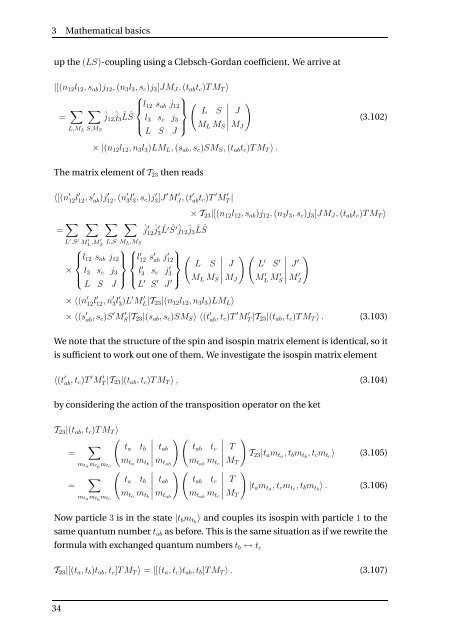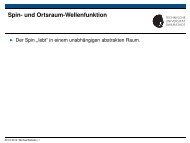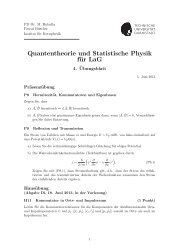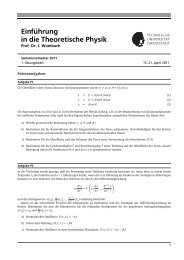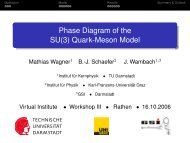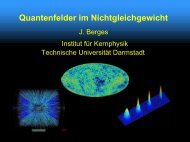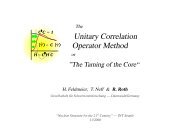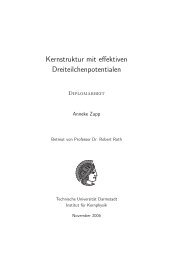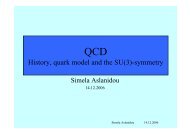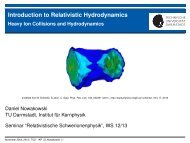Consistent chiral three-nucleon interactions in ... - Theory Center
Consistent chiral three-nucleon interactions in ... - Theory Center
Consistent chiral three-nucleon interactions in ... - Theory Center
You also want an ePaper? Increase the reach of your titles
YUMPU automatically turns print PDFs into web optimized ePapers that Google loves.
3 Mathematical basics<br />
up the (LS)-coupl<strong>in</strong>g us<strong>in</strong>g a Clebsch-Gordan coefficient. We arrive at<br />
|[(n12l12, sab)j12, (n3l3, sc)j3]JMJ, (tabtc)TMT 〉<br />
= <br />
ˆj12<br />
L,ML S,MS<br />
ˆj3 ˆ L ˆ ⎧ ⎫<br />
⎪⎨ l12 sab j12⎪⎬<br />
<br />
L S<br />
<br />
<br />
S l3 sc j3 <br />
⎪⎩ ⎪⎭ ML MS<br />
L S J<br />
J<br />
MJ<br />
× |(n12l12, n3l3)LML, (sab, sc)SMS, (tabtc)TMT 〉 .<br />
The matrix element of T23 then reads<br />
〈[(n ′ 12 l′ 12 , s′ ab )j′ 12 , (n′ 3 l′ 3 , sc)j ′ 3 ]J ′ M ′ J , (t′ ab tc)T ′ M ′ T |<br />
= <br />
<br />
<br />
<br />
L ′ ,S ′ M ′ L ,M′ L,S ML,MS<br />
S<br />
⎧ ⎫⎧<br />
⎪⎨ l12 sab j12⎪⎬<br />
⎪⎨<br />
× l3 sc j3<br />
⎪⎩ ⎪⎭ ⎪⎩<br />
L S J<br />
ˆj ′ 12 ˆj ′ 3 ˆ L ′ ˆ S ′ˆj12 ˆj3 ˆ L ˆ S<br />
l ′ 12 s ′ ab j′ 12<br />
l ′ 3 sc j ′ 3<br />
L ′ S ′ J ′<br />
<br />
(3.102)<br />
× T23|[(n12l12, sab)j12, (n3l3, sc)j3]JMJ, (tabtc)TMT 〉<br />
⎫<br />
⎪⎬<br />
<br />
L S<br />
<br />
<br />
<br />
⎪⎭ ML MS<br />
J<br />
MJ<br />
× 〈(n ′ 12 l′ 12 , n′ 3 l′ 3 )L′ M ′ L |T23|(n12l12, n3l3)LML〉<br />
<br />
L ′ S ′<br />
M ′ L M ′ S<br />
<br />
<br />
J<br />
<br />
<br />
′<br />
<br />
× 〈(s ′ ab , sc)S ′ M ′ S |T23|(sab, sc)SMS〉 〈(t ′ ab , tc)T ′ M ′ T |T23|(tab, tc)TMT 〉 . (3.103)<br />
We note that the structure of the sp<strong>in</strong> and isosp<strong>in</strong> matrix element is identical, so it<br />
is sufficient to work out one of them. We <strong>in</strong>vestigate the isosp<strong>in</strong> matrix element<br />
〈(t ′ ab , tc)T ′ M ′ T |T23|(tab, tc)TMT 〉 , (3.104)<br />
by consider<strong>in</strong>g the action of the transposition operator on the ket<br />
T23|(tab, tc)TMT 〉<br />
= <br />
<br />
mtamt b mtc<br />
= <br />
mtamt b mtc<br />
<br />
ta tb<br />
mta mtb<br />
ta tb<br />
mta mtb<br />
<br />
<br />
<br />
<br />
<br />
<br />
<br />
<br />
<br />
<br />
tab<br />
mtab<br />
tab<br />
mtab<br />
<br />
<br />
tab tc<br />
mtab mtc<br />
tab tc<br />
mtab mtc<br />
<br />
<br />
<br />
<br />
<br />
<br />
<br />
<br />
<br />
<br />
T<br />
MT<br />
T<br />
MT<br />
<br />
<br />
M ′ J<br />
T23|tamta, tbmtb , tcmtc〉 (3.105)<br />
|tamta, tcmtc, tbmtb 〉 . (3.106)<br />
Now particle 3 is <strong>in</strong> the state |tbmtb 〉 and couples its isosp<strong>in</strong> with particle 1 to the<br />
same quantum number tab as before. This is the same situation as if we rewrite the<br />
formula with exchanged quantum numbers tb ↔ tc<br />
T23|[(ta, tb)tab, tc]TMT 〉 = |[(ta, tc)tab, tb]TMT 〉 . (3.107)<br />
34


